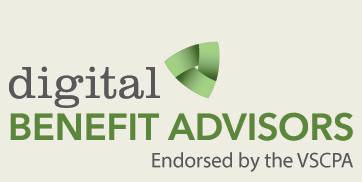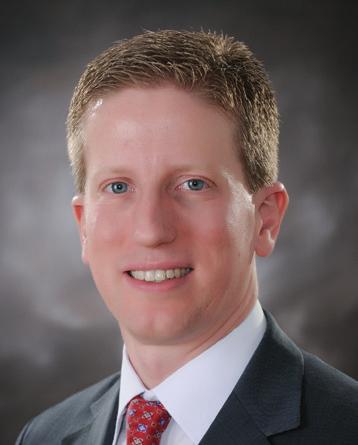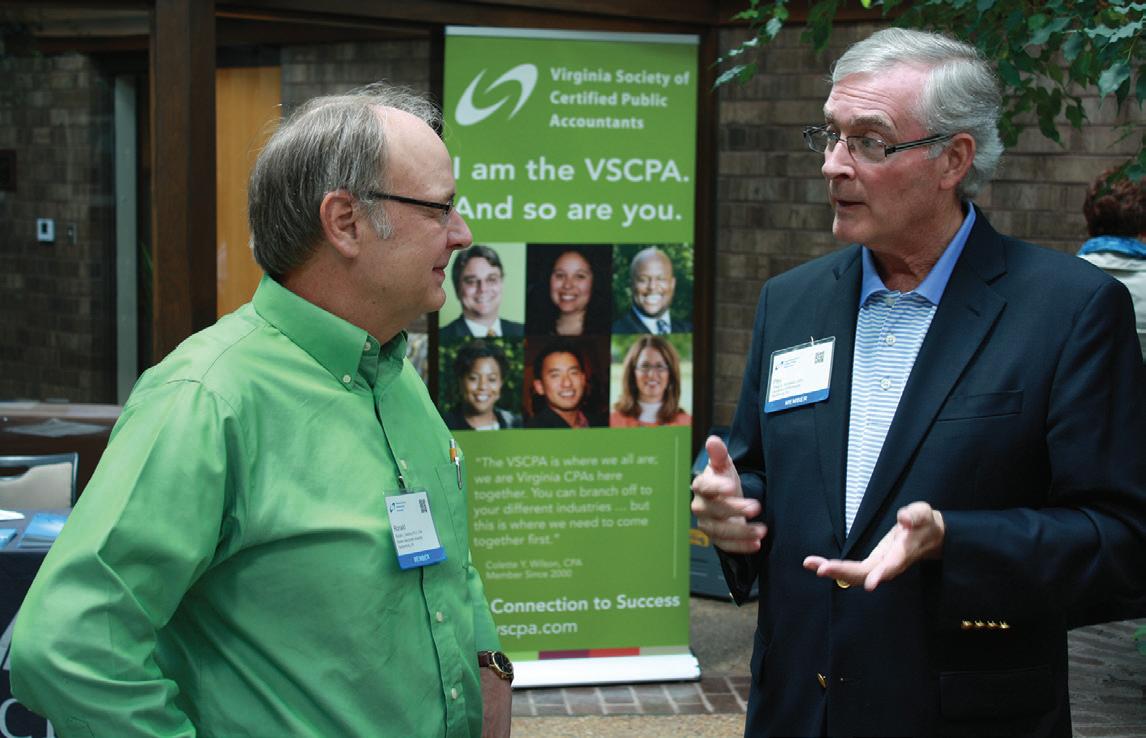IF
peer review Government contracting




















































By viewing the federal government’s financials with the same critical eye we would give a public company, America’s dire financial situation becomes clear.
Requests for equitable adjustment (REA) can protect contractors in the event of major contract delays or changes.

Breaches of contract can bring businesses to an abrupt halt with costly and burdensome consequences. Luckily, CPAs can be invaluable assets on breach of contract cases.
Celebrating peer review 25 years in.
To pay for the federal government’s promises in today’s dollars, every man, woman and child would have to write a check for $203,155.


Aon
A. Berk, CPA
Benefit Advisors
Insurance

PNC Bank
Group Advisors
& Mary Law School

published bimonthly for
of the Virginia Society of CPAs.


to
the
of
VIRGINIA SOCIETY OF CPAs 4309 Cox Road Glen Allen, VA 23060 (800) 733-8272 Fax: (804) 273-1741 www.vscpa.com
Jill Edmonds
Managing Editor disclosures@vscpa.com
Chip Knighton Contributing Editor cknighton@vscpa.com
Jenny Chu, CAE Marketing & Communications Director jchu@vscpa.com
Joan D. Aaron, CPA
Lindsay S. Andrews, CPA
Adam G. Chaikin, CPA
David L. Cotton, CPA
Gary D. Dittmer, CPA
Elizabeth M. Helle, CPA
Clare K. Levison, CPA
Kevin S. Matthews, CPA David R. Peters, CPA
George D. Strudgeon, CPA Barbara Sukramani, CPA Thomas L. Visotsky, CPA
Articles and advertising for future issues are due by 5 p.m. on the following dates:
Nov./Dec. 2014 Sept. 1, 2014
Jan./Feb. 2015 Nov. 3, 2014
March/April 2015 Jan. 5, 2015
July/Aug. 2015 March 2, 2015
Sept./Oct. 2015 July 6, 2015
Nov./Dec. 2015 Sept. 1, 2015
Statements of fact and opinion are made by the authors alone and do not imply an opinion on the part of the officers, members or editorial staff.
Connect is a valuable resource especially for the sole proprietor. Connect participants become our colleagues “down the hall” that we can use to discuss issues, benefit from their knowledge and experience a larger firm information base. I enjoy sharing my knowledge with other colleagues and value their sharing with me and others on Connect. Happy Birthday Connect and all those who have made it possible.
Should Virginia expand sales tax to include professional services?
Yes, definitely 7 percent No way! 71 percent Only as part of comprehensive tax reform 13 percent Not sure / Need more info 10 percent
What kind of role should the VSCPA play in tax reform conversations?
None at all 1 percent Information resource 14 percent Advocate as it affects our members 55 percent Drive the conversation 29 percent Other 2 percent
From polls taken at VSCPA Professional Issues Updates and the Industry conference
The “Meet the Top 5 Under 35” article in the July/August issue of Disclosures referred to Brent Simer, CPA, working in the “lobbying field.” Simer is not a registered lobbyist, nor does he serve in a lobbying function. The VSCPA regrets the error.
Several Kogod undergrads attended the @VSCPANews Leaders’ Institute last month. These are their stories: bit.ly/1t3mSvL — @KOGODBIZ
We received a pass rating with no management comments on our internal quality controls from our peer review, certified by @vscpa, June 2014 — @CASTROANDCO
CPAs know more than accounting! @VSCPANews: Advisory services offer growth opportunity for CPA profession, per @barrymelancon — @MMAYCPA
BLOG: www.cpacafe.com
CONNECT: http://connect.vscpa.com
TWITTER: @VSCPANews, @FinancialFit

LINKEDIN: http://tinyurl.com/VSCPALinkedInGroup FACEBOOK: www.facebook.com/VSCPA INSTAGRAM: www.instagram.com/VSCPA
Get in touch At the Virginia Society of CPAs, we love to hear from you. Whether it’s a quick email to a staff member, chat on the phone, Disclosures letter to the editor, tweet, blog comment or something different altogether, let us know what you’re talking about, how you feel about different issues affecting CPAs and how we can help.



Beginning Sept. 1, 2014, the VSCPA will automatically transfer your VSCPA CPE credits to a tracking system run by the Virginia Board of Accountancy (VBOA) and the National Association of State Boards of Accountancy (NASBA). The new system streamlines CPE reporting both for those organizations as well as you, too.
Any coursework you completed through the VSCPA over the last four years, in which the VSCPA issued your certificate of attendance, will be transferred to the new system. The VSCPA’s ethics course, “Ethics — Your License Depends on It!” will be in your data transfer regardless of the format you attended. You may manually enter data on coursework completed through other providers at any time.
The VBOA is moving to a CPE audit rate of 5 percent, up from 3 percent, and the new system will help if the VBOA selects you for an audit. Moving forward, all VBOA audits will be electronic, and you must use the tracking system to transfer their credits and/or certificates. Because of the VSCPA’s automatic transfer, you will no longer have to compile and manually submit your VSCPA coursework to the VBOA. Please note that the VBOA will not use this data unless you are selected for a CPE audit.
The opt-out date for the initial data transfer has already passed. However, you can opt out at any time, and the automatic data transfer of your completed CPE coursework will be terminated.
Check out the VSCPA’s FAQ on the new reporting system at http://tinyurl.com/VSCPACPEreporting or scan the QR code with your smartphone. n

The American Institute of CPAs’ (AICPA) State Regulation and Legislation Team is urging CPA firms to review their registration compliance procedures to ensure they are in compliance with out-of-state registration requirements when performing attest engagements.
This recommendation was released in light of recent activity by some state boards of accountancy to ensure out-of-state firms operating in their states have met registration requirements. Check out www.cpamobility.org for more. n

Consider all client situations carefully to identify potential or actual conflicts of interest, which may affect your objectivity or independence — even if you are not engaged to do attestation work.
Examine conflicts of interest from a broad point of view, considering the client's perspective as well as those of other stakeholders such as owners, investors, partners, beneficiaries and spouses.
Troublesome scenarios can include a partnership breakup, a failed investment, bankruptcy, a trust, merger, divorce, family office services or anything else that can create opposing or disappointed factions. Claims with CAMICO are often triggered by CPAs advising two parties to a transaction (e.g., a buy-sell agreement), helping parties resolve a dispute or in some cases participating in business deals with clients. This is especially true when the CPA appears to favor one party over another, or may appear to no longer have the client’s best interests at heart, leading juries to sympathize with the client. n
Source: CAMICO. For more information and guidance about CPA firm insurance issues, visit www.camico.com.
The Uniform Accountancy Act’s (UAA) seventh edition, released in May, updates the definition of attest services and allows CPA firm mobility across state borders. While the UAA is not mandatory for states, it demonstrates best practices in state laws and regulations and is used by the National Association of State Boards of Accountancy (NASBA) and the American Institute of CPAs (AICPA).
The new UAA amends the definition of attest so that only CPAs operating within a CPA firm can perform:
>> Audits in accordance with Statements on Auditing Standards (SAS)
>> Reviews under Statements on Standards for Accounting and Review Services (SSARS)
>> Examinations, reviews and agreed-upon procedures under Statements on Standards for Attestations Engagements (SSAE)
>> Any engagement performed under Public Company Accounting Oversight Board (PCAOB) standards
There is an exception, however, for public officials and employees to perform these engagements.
On the firm mobility front, firms that are registered to provide attest services in one state may provide those services to clients in another state, if the state allows, without registering or paying fees to the second state. Currently, 51 jurisdictions (49 states plus the District of Columbia and U.S. Virgin Islands) are considered mobility states, which eliminates the need for a CPA to have multiple licenses in those states.
Virginia’s regulations are currently in alignment with the UAA revisions, so the Virginia Board of Accountancy (VBOA) will not need to pursue regulatory updates.
Need help understanding mobility? Check out the online mobility tool at www.cpamobility.org. n
More than one-third of the U.S. population belongs to a minority group, but only 10 percent of accounting professionals identify as minorities. Explore diversity topics and inclusion initiatives with Inclusion Solutions, a new, free e-newsletter from the American Institute of CPAs. Visit http://tinyurl.com/DiversityEnews to sign up. n
I remember working in the computer lab in college and seeing a coworker fly through all the various Windows commands with lightning-fast speed — using only keystrokes, zero use of the mouse! From that point forward, I have known what studies have proven; keys beat the mouse! I do like my shortcut key strokes like Ctrl + c to copy and Ctrl + v to paste, but I am not so obsessed that I never reach over to that handy mouse. However, there are few shortcut keys in Excel that can save time for anyone, like CPAs, who work with numbers and formulas.

an Auto Sum
Formats as Currency
Formats as Percentage
Formats with two decimal places
Shows all formula
If you think you would find one of these shortcuts helpful, I recommend cutting out the above box and placing it next to your computer. That way, it is available when you need it and you can trash it after it becomes second nature. There are likely hundreds of other shortcut key combinations. Nonetheless, you don’t need to learn them all — you only need to learn the few that you will use the most to increase your efficiency. n
GEORGE D. STRUDGEON, CPA, CGFM, is an audit director at the Virginia Auditor of Public Accounts in Richmond. He is a member of the VSCPA Editorial Task Force. Email him if you have Excel topics you want him to cover.
george.strudgeon@gmail.com connect.vscpa.com/GeorgeStrudgeon


The Commonwealth usually receives accolades for its economic policies, but unfortunately, it cannot boast about strong economic growth in 2013. According to the Bureau of Economic Analysis, Virginia was one of the three slowest growing states last year, demonstrating only 0.1 percent growth. Only Maryland and Alaska came in lower. Overall, the U.S. economy’s growth rate declined 0.9 percent from 2012, down to 1.9 percent.
Federal budget cuts due to sequestration affected Virginia, home to several major government contracting companies. Slow growth in the scientific and technical sectors also contributed to the ranking.
But there’s a positive. Despite a sluggish economy, Virginia boasts the 11th highest 2013 Gross Domestic Product, $453 billion, and the 13th lowest unemployment rate, 5.5 percent.
North Dakota, Wyoming and West Virginia saw the highest economic growth rates. In North Dakota, hydraulic fracturing (fracking) contributed to its 9.7 percent increase. n
What do Belgian, Australian and Latvian 15-year-olds have in common? They are all more financially literate than American students.
The Organization for Economic Co-operation and Development (OECD) released a study in July revealing the financial literacy scores of 29,000 students in 18 countries. The United States ranks in the middle — No. 9 with a score of 492, eight points behind the average score of 500. Shanghai is the leader.
The students took a two-hour paper test with questions ranging from basic financial literacy skills to more complex scenarios. Check out more on the survey under “Education” at www.oecd.org. n
It may seem different come mid-April, but U.S. citizens actually have a light income tax burden when compared to other countries. A report from the Tax Foundation revealed that in 2013, Americans paid 31 PERCENT of their income, on average, in taxes. That was only the 26th highest rate and below the average of 36 PERCENT Belgians have the highest: 56 PERCENT n
The amount that the average U.S. college graduate will earn more than the average high school graduate, according to a study from the Federal Reserve Bank of San Francisco. The number also takes into account the cost of college tuition and four years of lost wages during the average time a student is in college. n

and



It is easy to take for granted the way the profession is today — and assume it’s always been that way. Ours is an evolving and dynamic profession. This column looks at the way we were a quarter-century ago.
The August 1990 issue of Disclosures featured an article by Thomas S. Watson Jr. called “Some impacts of EC 1992 on CPAs in the United States.” Watson was a global thinker before the term “global” took on the meaning we give it today. His article gave a brief summary of the history of the European Community (EC). In 1985, the EC had approved the Single Market program (commonly referred to as EC 1992) designed to remove trade barriers among the then 12 member states of the EC. The overall goal was to make the EC a powerful economic force, capable of competing with the United States. Watson posited that “by 1992, products should be able to move as freely within the EC as they do in the United States.”
Watson made several predictions about the effect of EC 1992 on CPA firms in the United States. He said that the emerging European market would have a major impact on U.S. businesses and would precipitate an influx of investors into the United States, especially in the Baltimore/Washington/Richmond/Norfolk corridor. “Each foreign
investor coming into the United States is a potential new client for CPA practitioners,” he advised.

He predicted that the “consolidation of the European Community in 1992 will set forces in motion that will change the practice of public accounting in the United States.” The European Parliament was in the process of passing an accountancy law setting the rules for financial reporting and auditing for all EC members. This, in turn, would put pressure on the United States to implement uniform accountancy rules for CPA firms across all of the states.
As the world shrank and business activity transcended geographic boundaries, there would be a need for common accounting principles and auditing standards so that global companies would not need to publish multiple sets of financial statements and have multiple audits to meet the rules of each country in which they did business.
Watson’s article proved to be remarkably prescient. The Maastricht Treaty formally established the European Union (EU) in 1993, taking EC 1992 several steps further in creating a unified European economy. In 2002, the Euro was introduced, establishing a common currency for most EU members. In July 2013, Croatia became the 28th nation to join the EU.
In terms of uniform accountancy rules, the European Parliament established its current rules (Directive 2006/43/EC) in 2006 covering “statutory audits of annual accounts and consolidated accounts.” These rules were aimed at “high-level — though not full — harmonisation of statutory audit requirements. A Member State requiring statutory audits may impose more stringent requirements, unless otherwise provided by this Directive.” This EU directive is quite similar, in fact, to the Uniform Accountancy Act (UAA) in the United States designed to make it easier for CPAs to practice across state boundaries. The adoption of the UAA has been a slow process, but currently, 51 of 55 U.S. licensing jurisdictions have embraced CPA practice mobility, a “practice privilege that generally permits a licensed CPA in good standing from a substantially equivalent state to practice outside of his or her principle place of business without obtaining another license.” See https://www.cpamobility.org for more information on mobility.
Uniform accountancy rules did not happen as quickly in either Europe or the United States, as Watson predicted. The convergence of global accounting principles and auditing standards has proven to be a similarly slow process.
In 2002, the EU mandated that companies listed on EU stock exchanges
prepare financial statements in accordance with International Financial Reporting Standards (IFRS) beginning in 2005. The United States had planned to achieve “convergence” with IFRS by now. But, as the Financial Accounting Standards Board (FASB) and the International Accounting Standards Board (IASB) have studied the issue, full convergence has proved to be elusive. Instead of simply agreeing on adoption of IFRS for U.S. companies, the two boards have decided to work “jointly on areas identified for improvement in IFRS and U.S. GAAP.” The boards no longer predict a date for completion of these convergence projects.
Convergence of auditing standards has turned out to be equally challenging. We have three major audit standard-setting organizations in the United States (the Auditing Standards Board, the Government Accountability Office, and the Public Company Accounting Oversight Board) with distinct standards. So, full convergence with the international audit standard-setting organization (the International Federation of Accountants) will take a while. But all four bodies are focused on harmonization and avoiding unnecessary conflicts as they move forward.
In 1990, Thomas Watson had a vision of the global economy and the important and evolving role of the CPA in its future. The fact that globalization and convergence has not happened quickly makes his vision all the more impressive: he saw past the geopolitical and nationalistic hurdles and envisioned the eventual future that is now emerging. n
DAVE COTTON, CPA, is partner at Cotton and Company, LLP, in Alexandria. He is a former VSCPA Board of Directors member and currently sits on the VSCPA Editorial Task Force. He joined the VSCPA in 1981. * dcotton@cottoncpa.com connect.vscpa.com/DavidCotton

Virginia Society of Certified Public Accountants members are rewarded.
As a member of VSCPA, you can save with special discounts on Nationwide ® auto insurance. In addition, when you add rewards like Vanishing Deductible® , * you can take $100 off your deductible for every year of safe driving, for up to $500 in savings.
You wouldn’t be involved with VSCPA if you weren’t passionate about being part of a group that shares your values. We understand that feeling, because we treat customers like members. It’s one of the things that make us a different kind of insurance company.
Call Ronnie Shriner at (877) 683-3364 or visit nationwide.com/cps/pc-affinity-vscpa.htm for a quote today!
Did you know that the American Institute of CPAs (AICPA) Peer Review Program is 25 years old this year? Peer reviews can be challenging and sometimes a little painful, but if taken seriously, they can also be a chance to significantly improve a firm’s audit and accounting practice. Though I am heavily involved in the peer review process, I am not exempt from the challenges of preparing for and undergoing the peer review for my firm.
The program, administered by the VSCPA, was initially known as the Quality Review Program and now serves as the primary peer review program for public accounting. The structure of peer review remains relatively unchanged, but the program has certainly matured over the years and has continued to develop into the sophisticated program that it is today.
Anyone who has worked in public accounting knows that the guidance we must follow on a daily basis is in a constant state of change, including the way we audit, documentation requirements, reporting requirements, ethical standards, tax matters and so forth. Certain firms deal with the changing environment with ease. Other firms have trouble dealing with the changes and often find that their work does not conform to professional standards. The causes of these problems vary, but often can be traced to the leadership within the firm and the firm’s failure to place emphasis on their quality control system.

In my observation, firms that have had multiple peer reviews have improved over the years. Many of the peer reviews for these firms often have few findings of significance and serve as an affirmation that the firm’s culture is sound and is grounded in professional standards.
Characteristics of firms with successful peer reviews include:
>> Leadership dedicated to excellence in audit and accounting matters
>> Continuing education that is current, balanced and relevant to the firm’s practice
>> High standards for documentation and a comprehensive working paper structure
>> Subscription and effective implementation of comprehensive third-party quality control materials
>> Effective policies and procedures pertaining to acceptance of clients and engagements and review of engagements at multiple levels
>> Perpetual monitoring procedures that ensure a properly designed system of quality control and compliance with firm policies and procedures
On the other end of the scale, however, there are firms whose quality control systems are characterized by significant problems. Leadership in these firms does not place the proper emphasis on the importance of conforming to professional standards. Their quality control systems often include third-party quality control materials that are out-of-date or not properly implemented within the firm. The firm’s professional personnel often take inappropriate continuing professional education and are not properly trained for the complex and changing environment of the audit and accounting world. The firm’s monitoring of its practice is sometimes minimal and problems that exist are not identified properly and corrected promptly. Peer reviews of these firms are generally complicated, and often result in engagements that do not conform to professional standards. In those situations, peer review can be a very unpleasant process for both the reviewer and reviewed firm.
Many of the problems noted in peer reviews, some significant and some not so significant, relate to newly issued standards or standards that are complicated and difficult to apply. It puzzles me when firms have relatively significant audit and accounting practices, yet spend
so little effort in keeping up with the changes that directly affect such an important part of their practices. I have also seen firms that have a significant investment in practice aids and education, but do not effectively use those aids or practice what they have been taught.
The reporting on compilation and review engagements was changed by the Statements on Standards for Accounting and Review Services (SSARS) 19, which became effective for compilation and reviews engagements with periods ending after Dec. 15, 2010. Even though this pronouncement has been in effect for several years now and has been the subject of numerous CPE programs, many in public accounting have not adopted the new reporting requirements and are still using the “old” report formats. Engagements using the old report formats are deemed to be nonconforming; firms may have to take certain corrective actions to ensure they are aware of future changes affecting their practices.
The reporting for audit engagements also changed significantly for periods ending after Dec. 15, 2012, with Clarity Standards. These reporting requirements, along with other changes to professional standards, received significant coverage in CPE courses leading up to implementation dates, yet many accountants are not aware of and have not implemented any of the changes. Audit reports that do not incorporate these standards also do not conform to professional standards.
Common missing disclosures recently noted in peer reviews include the failure to disclose tax years that remain open and subject to examination by taxing jurisdictions; the date to which management has reviewed subsequent events; and disclosing the fair value hierarchy of investments. These are generally not considered to be significant departures from standards, but do indicate that more recently required disclosures are those commonly missed in financial statements.
There have been significant changes to independence considerations to recent years, particularly to engagements subject to Government Auditing Standards. Many firms have been slow to conform to the new standards, which often results in substantial noncompliance.
Monitoring a firm’s practice is an important element of any quality control system to ensure adequate design and compliance. Peer reviewers have noted in many instances that this process is often overlooked by firms or not documented properly. The scope of monitoring procedures includes a review of firm policies and procedures, independence issues, continuing professional education, human resource issues, acceptance and continuance of clients and engagement performance, among other procedures. The performance and documentation of monitoring procedures should not be overlooked.
There are many other areas identified over the years that are too numerous to discuss here. Peer reviewers are charged with the responsibility of not only identifying these issues, but also determining the cause of the issues within the firm’s quality control system. In doing
so, appropriate recommendations for improvement can be made and firms can implement changes and improve their audit and accounting practices. Firms should emphasize the importance of dealing effectively with the issues noted in their peer reviews.
On July 1, 2013, the Peer Review Program implemented a positive change that will be a benefit to the peer review process. On this date, Matters for Consideration Forms (MFC) went online through PRISM, the AICPA’s Peer Review Information System Manager. As you may know, MFCs are generated on peer reviews upon the occurrence of issues noted in the course of peer review performance. In prior years, these forms were independently generated and any means of summarizing issues noted on peer reviews was a laborious process based on information that was not always clearly defined. The new process requires the completion of the MFC forms online, standardizes professional references related to the matters and has safeguards to ensure the completeness of the forms. Forms, completed on the AICPA website, are exchanged between the reviewers and reviewed firm through email. The ability to identify and quantify problem areas in the profession is a great value to the profession. The process is just over a year old now, and the results are being analyzed.
The Peer Review Program has been a positive force in the profession over its 25 years, increasing the quality of work performed by firms. Firms being reviewed should look for reviewers not only to meet compliance issues, but also to add value to their practices. The good ideas and practices that are exchanged benefit everyone involved. Look at the peer reviewer as a resource to help improve your practice. The public depends on our profession for many services; peer review helps us to do it right.
As the program matures, the Peer Review Program faces the aging and retirement of many of its reviewers and the program is in constant search for peer reviewers. Getting involved will require some education and performing peer reviews may require some travel, but it is a learning experience that exposes CPAs to other practitioners and can be a rewarding part of a CPA’s practice. n
ROBERT M. MOORE JR., CPA, is a member of Boyce, Spady & Moore PLC in Suffolk. He is an original technical reviewer in the American Institute of CPAs (AICPA) Peer Review Program and a former VSCPA Board member.
* rmoorejrcpa@yahoo.com connect.vscpa.com/BobMoore

 BY TOM VISOTSKY, CPA
BY TOM VISOTSKY, CPA
A fiscally unsustainable federal government threatens our nation and every American.
>> Consistently loses money every year
>> Projects that its losses will continue indefinitely
>> Receives qualified opinions annually from its auditors
>> Spends all trust fund assets to cover operating expenses
>> Has large unfunded liabilities (UL), both on and off its balance sheet, and
>> Has a dysfunctional “management” and “board of directors”?
Answer: The United States government, which, incidentally, carries an AAA bond rating from two of the major rating firms!
According to the U.S. Government Accountability Office (GAO), the “federal government continues to face an unsustainable long-term fiscal path.” In the current polarized political environment, this article seeks to analyze, in a nonpartisan way, where we are as a nation and where we are headed if a course correction is not made soon. Let’s look at the biggest areas of risk and concern.
The government’s annual report, published by the U.S. Treasury Department, is 246 pages long; however, it includes a Management’s Discussion and Analysis section that highlights the primary issues facing the country. In addition, Treasury also publishes The Citizen’s Guide to the Fiscal Year 2013 Financial Report of the US Government, which is only seven pages long and provides a great summary of the fiscal big picture. Both are available as a free download at www.fms.treas.gov/fr.
The government’s annual financial report comprises a number of statements, but they can be viewed as three primary component areas:
>> Balance Sheet and set of cost-related schedules
>> Statement of Social Insurance that reports on Social Security and Medicare
>> Statement of Long Term Fiscal Projections
In its audit report, the GAO stated that “overall, significant progress has been made since the enactment of key federal financial management reforms in the 1990s; however, our report on the U.S. government’s consolidated financial statements underscores that much work remains to improve federal financial management, and these improvements are urgently needed.”
Significant concerns included:
>> Significant uncertainties in the achievement of projected reductions in Medicare cost growth (discussed below)
>> Material weaknesses in internal control over financial reporting
>> Inadequate support for “significant portions of the reported total net cost of operations, most notably related to [the Department of Defense]”
>> Failure to “adequately account for and reconcile intragovernmental activity and balances between federal entities”
The government had a Net Operating Cost (Loss) (NOL) of $805 billion in Fiscal Year 2013; liabilities of $19.9 trillion; additional debt to trust funds (TF) of $4.8 trillion; and unfunded liabilities (UL) for future trust fund payouts of $39.7 trillion. So what do these huge numbers mean?
To compare this to a corporate perspective, the almost unimaginable numbers are converted in Table 1 (see page 16) to various
stakeholder amounts. Instead of a loss per share or debt per share, Table 1 shows some relevant loss and debt per stakeholder balances (also see footnotes 1 and 2 in the table).
The Unfunded Liabilities are calculated on a present value (PV) basis. These amounts represent the total required to be put aside and invested today, in order to pay for the benefits promised for social insurance and federal retirement programs over the next 75 years. As no action appears on the horizon, these liabilities are virtually certain to grow every year until Congress decides to address the problem.
Basically, in order to pay for the government’s promises in today’s dollars, each man, women and child would have to write a check for $203,155. Since not many children have savings, a tax on every worker would require $453,521. Since not many part-time workers have large savings, we could tax all full-time workers $544,839. Under the alternative projection of UL, these amounts would rise to $231,230; $516,197; and $620,135, respectively.
The SOS “shows how much more money would be needed, in today’s dollars for the federal government’s social insurance programs to continue to operate over the long term as they are structured today.” The off-balance sheet liability for social insurance programs is at least $39.7 trillion. This comprises:
$12.3 trillion Social Security
$15.7 trillion Medicare Part B [provider (doctor) coverage]
$ 6.9 trillion Medicare Part D (prescription drug card) $ 4.8 trillion Medicare Part A (hospital coverage)
$39.7 trillion Total SOS Unfunded Liabilities u
1. According to the U.S. Census Bureau, Current Population Survey, 1968 to 2013 Annual Social and Economic Supplements, there are 142 million workers, 118.2 million of which were Full Time (FT). The Census Bureau’s Population Clock indicates that the U.S. population on Sept. 30, 2013, was approximately 317 million.
2. Liabilities of $19.9 trillion consist of $12 trillion of debt held by the public and accrued interest, $6.5 trillion of federal employee and veteran benefits and $1.4 trillion of other and rounding.
3. The alternative projection of additional UL is discussed further in the article.
The GAO was prevented from expressing (disclaimed) an opinion on the SOS and the Statements of Changes in Social Insurance Amounts “because of significant uncertainties … primarily related to the achievement of projected reductions in Medicare cost growth.” Proposed cutbacks in physician reimbursement and efficiencies claimed in the Affordable Care Act (ACA) claim to reduce costs, but “there is uncertainty about whether the projected cost savings, productivity improvements, and reductions in physician payment rates will be sustained in a manner consistent with the projected cost growth over time.”
The 2013 Medicare Trustees’ Report warns that the “actual future costs for Medicare are likely to exceed those shown by the current-
law projections.” An alternative projection of costs indicates that the $27 trillion UL for Medicare could be exceeded by nearly $9 trillion, increasing total SOS ULs from nearly $40 trillion to nearly $49 trillion.
The government has a very loose definition of “trust fund.” Over the years, the Social Security and Medicare trust funds have accumulated about $4.8 trillion in excess receipts over disbursements and placed these amounts in trust funds that are supposedly reserved for future benefit payments. All of this money has, in fact, been spent and replaced by “special,” non-negotiable U.S. Treasury securities.
Let’s say a company called Wishful Thinking, Inc. (WTI), puts money for pensions in a retirement fund for their employees, borrows
all the money, puts a non-negotiable IOU in a box and then spends all the money to cover annual operating expenses and NOLs. As a corporation doing this, WTI would have to at least record a liability to the fund on their financial statements. The trustees and corporate officers might also face indictment. The federal government, however, looks at the funds as being part of the government; so the $4.8 trillion liability is eliminated in the consolidation. “Under federal accounting rules, social insurance expenditures, as reported in the Statement of Social Insurance (SOSI) and the Statement of Long-Term Fiscal Projections … are not considered liabilities of the Government.”
Department of Defense (DOD) operated at a gross cost of $685 billion, with a net cost of $577 billion. Costs would have been higher
except for a somewhat extraordinary gain of $63 billion from changes in assumptions in “actuarial projections of their long-term benefits liabilities and their related costs.”
According to the Stockholm International Peace Research Institute, the United States spends as much on defense as the next nine largest spenders combined (China, Russia, Saudi Arabia, France, United Kingdom, Germany, Japan, India and South Korea).
The amount that should be spent on defense is hard to say. However, Robert Gates, former Secretary of Defense (2006–2011) and former director of the Central Intelligence Agency indicated in his book “Duty” that military “budgets are locked in for years at a time, and all the bureaucratic wiles of each military department are dedicated to keeping those programs intact and funded. They are joined in those efforts by the companies that build the equipment, the Washington lobbyists that those companies hire, and the members of Congress in whose states or districts those factories are located. Any threats to those long-term programs are not welcome. Even if we are at war.”
The DOD represents about 33 percent of the government’s total assets and 16 percent of net costs, but the GAO states it could not render an opinion due to “serious financial management problems at DOD that have prevented its financial statements from being auditable.” To correct this deficiency, the DOD Comptroller established the Financial Improvement and Audit Readiness Directorate, which has an “overall goal of preparing auditable department-wide financial statements by Sept. 30, 2017.”
The government closed FYE 2013 with an $805 billion NOL; $12 trillion of publicly held debt and $6.5 trillion of liabilities for federal employee and veterans benefits. As the government takes advantage of near zero interest rates on the short end, more and more debt gets rolled over each year. To finance this $805 billion shortfall, the government borrowed $8.145 trillion and paid off $7.444 trillion. The more than $8.1 trillion borrowed
last year represents 67 percent of all federal debt outstanding. This implies that the average maturity of all debt outstanding is less than two years, meaning the U.S. is exposed to both interest rate and liquidity risks much greater than if the outstanding debt was concentrated in 10- or 30-year bonds.
The Bank for International Settlements (BIS), a consortium of the world’s top central banks, released its annual report in June 2014. The organization warned that “keeping interest rates unusually low for an unusually long period can lull governments into a false sense of security that delays the needed consolidation” (of debt). BIS General Manager
Jaime Caruana warned that “higher debt translates into greater financial fragility and financial cycles that may become increasingly disruptive.” The BIS noted that debt exceeded 100 percent of gross domestic product in most major economies, including the United States. According to the U.S Department of Commerce, Bureau of Economic Analysis, GDP was $17.09 trillion in 2013. The government reported “gross federal debt” of $16.7 trillion (total of publicly held and intragovernmental debt), which would calculate as 98 percent of GDP.
A normalization of monetary policy could lead to interest rates at or above historical levels. With much U.S. debt at 50 basis points or less, even a rise to 2.5 percent would cost the government at least an additional $240 million per year. A rise to 4.5 percent would cost $480 million additional per year, and that is at 2013 debt levels.
The Federal Reserve Bank (Fed) has taken extraordinary measures to stimulate the economy by facilitating the government’s borrowing with low interest rates. However, it should be noted that none of the Federal Reserve System’s activities is “included in the federal budget. It is considered an independent central bank, and its decisions are not ratified by the executive branch of the Federal Government.” Also excluded from the statements are all fiduciary funds
and Government Sponsored Enterprises (GSEs), such as the Federal National Mortgage Association (Fannie Mae), Federal Home Loan Banks, Federal Home Loan Mortgage Corporation (Freddie Mac) and Federal Farm Credit Bank.
The Fed held $4.3 trillion of assets “purchased” at FYE 2013, including $1.93 trillion of Treasury securities, and $1.4 trillion of Mortgage Backed Securities (MBS) guaranteed by GSEs. The Fed euphemistically calls these large-scale asset purchase programs an “expansion of their balance sheet,” which actually sounds very positive.
The Fed has bought about 16 percent of all publicly held federal debt outstanding, primarily by printing money. If and when the Fed decides to “reduce its balance sheet,” the market will have to absorb these securities in addition to debt being rolled over, new debt necessary to finance ongoing operating deficits and debt necessary to finance significant projected deficits in SOS programs like Social Security and Medicare.
It is clear that the government is facing enormous financial challenges. What is less obvious is how this will impact state and local governments. To help foster a greater understanding of the fiscal relationship between the federal government and state governments, CliftonLarsonAllen LLP published Intergovernmental Financial Dependency 2013: An Annual Study of Key Dependency Measures for the 50 States. The study was co-authored by Ed Mazur, CPA, senior advisor for Public Sector Services, and Taylor Powell, Public Sector Services senior associate. Ed, a VSCPA member, served as controller of the Office of Federal Financial Management in OMB and as State Comptroller of Virginia.
The 2013 study describes how states depend on the federal government based on direct revenues, direct federal grants to local governments, federal purchases from state businesses and federal payments to u
individuals. The study reports that direct and indirect federal flows to the states totaled $3.263 trillion in 2011. Of this total, $138.6 billion flowed to Virginia, which equated to 36.9 percent of Virginia gross domestic product.
Mazur stated that it is critical for state and local governments to consider the total impact of federal spending on their budgets, noting that sequestration not only reduces direct grants and other direct flows, but affects state and local economies as federal procurements and military spending are reduced. Mazur notes that federal cuts result in reduced state budgets, which, in turn, reduce state flows to cities, counties and other local governments. This increasingly dynamic environment necessitates, Mazur encourages, state and local governments to strengthen their financial reporting to include the disclosure of concentrations of revenue, the potential of credit risk on held federal securities and the existence of intergovernmental dependency.
In Treasury Secretary Jacob Lew’s cover letter to the government’s financials, A Message from the Secretary, he cites the Affordable Care Act (ACA) as one of “three laws (that) have substantially reduced the estimated long-term fiscal gap;” refers to the $680 billion cashbased budget deficit, but fails to mention this is actually $805 billion on an accrual basis; and states that “while this report is a testament to the strength and resilience of the U.S. economy, it also reminds us to stay on the path toward fiscal sustainability (emphasis added).”
The GAO, the government’s auditors, however, disclaimed an opinion, partly related to unproven savings in the ACA and specifically stated that we are on an “unsustainable fiscal path” (emphasis added).
The Financial Report of the U.S. government and the related Citizen’s Guide are available to anyone who is interested. R. Scott Bell, Office
of Fiscal Assistant Secretary, U.S. Department of Treasury, stated that “Treasury submits the Financial Report to specific Congressional committees, as well as the President and Vice President ... members of the Treasury press Corps, which include key national outlets and wire services,” and distributes thousands of copies of the Citizen’s Guide upon request. Treasury also makes the Financial Report and Citizen’s Guide available online, featuring a “more interactive version of the Financial Report site, enabling the user to more easily navigate within the Report, see detailed data behind some of the charts and access “external” information referenced in the Report, such as relevant statutory and/or policy documents and other agency financial reports and Trustee reports.” The Citizens Guide has also been used and presented in conferences sponsored by such organizations as the American Institute of CPAs (AICPA) and Association of Government Accountants as well as being presented annually to attendees of the Organization of Economic Cooperation and Development’s Public Sector Accruals Symposium. It is also utilized in college classrooms across the country, including such Virginia institutions as George Mason University and The College of William & Mary.
The House and Senate have held meetings in recent years concerning the Financial Report and audit. Bell indicated that “Treasury has been … included among panelists invited to testify at these hearings, (but) has not been contacted this year with respect to any hearings concerning the FY 2013 Financial Report.”
The government’s deficits, outstanding debt and unfunded liabilities are so large they are hard to comprehend. By converting these large numbers into stakeholder amounts, hopefully it is easier for people to understand the gravity of the U.S. financial condition and to encourage their Congressional representatives to take corrective action before the numbers get even worse.
Medicare Part D was passed in 2003 and became effective in 2006. Would the bill have still passed if it was reported at the time that the president and members of Congress were committing to another unfunded liability of $6.9 trillion? Would every full-time worker have been willing to pay a one-time tax of $58,375 to pay for the benefits provided by this coverage? They say the fastest way to get out of a hole is to stop digging. Unfortunately, the shovels in Washington are operating 24/7, 365 days a year.
Ask yourself these questions:
Would you vote for someone who actually promised to stop digging?
If the DOD proposed closing a base or reducing shipbuilding in Virginia, would you call your Congressman to fight for Virginia jobs or support the DOD in reducing costs?
Would you support reductions in Social Security and Medicare payments across all age groups to reflect our ability to pay, or would you vote for those 55 and older to receive full benefits, and reduce the benefits available to our children and grandchildren?
The devil is in the details. Hopefully this information makes you think the next time you’re promised a free lunch. n
TOM VISOTSKY, CPA, is a VSCPA past president and is currently consultant serving as interim finance director for First Baptist Church in Richmond. He is also a member of the VSCPA Editorial Task Force.
* tvisotsky@comcast.net connect.vscpa.com/TomVisotsky

Are you/your professional staff really at the right level where you should be/you need them to be?
Are you/your staff in a position that truly suits your/their personality, values, and professional and personal needs?
If you’re seriously interested in making the “right” move for your next hire, I can help you I am an actively licensed CPA in Maryland and Virginia with over 20 years of experience including public accounting (E&Y) and consulting (KPMG), financial accounting (American Cancer Society), internal audit (Moneyline Tele rate), and recruiting (Acsys, formerly Don Richards). As a networker who truly enjoys helping others and sharing my career experiences to guide fellow professionals, here is how I can help you:
Ask you questions, and most likely ask many more questions than other recruiters about your company, duties involved, skills required, corporate culture and more
Work with you on finding the “right” professional that is the “right fit”
Provide you with valuable information about the professionals I work with, the marketplace, what your competitors pay, and more
Guide you on career paths available in public accounting and industry
Enable you to capitalize on your strengths
Coach you on how to put your best foot forwa rd to find the “right fit”
Advise you when to stay in your current position if that is the right move
If you’re interested in working with a recruiter who understand s your background, skills, and is genuinely interested in helping you find the “right fit
then I welcome meeting you!
Specializing in CPA Firm, Accounting & Finance Positions in Metropolitan DC &
Suburbs/B
Connecting You To Your Next Hire TM Contingency & Retained Staffing Solutions matching skills, experience & values with needs
Recruiter
 BY SAM DAVIDSON
BY SAM DAVIDSON
Contracting with the government is not all one-sided there are both advantages and disadvantages to the contractor. A disadvantage is the government’s right to make changes in the agreed-to contract tasks, including which tasks are to be performed and how and when. An advantage to the contractor, however, is the right to request for equitable adjustment (REA) in contract price and/ or schedule as a result of contract changes initiated by government action or inaction.
In today’s environment of sequestration, continuing resolutions, debt ceilings, the lack of realistic budgets, significant ideological differences and the lack of compromise, taking advantage of the cost recovery offered by the REA process can be essential to all government contractors.
The REA cost adjustment is based on the impact or harm to the contractor represented by the difference between the reasonable cost of contract performance without the change or changes and the reasonable actual cost of performance resulting from the change or changes. It is not the difference between the negotiated cost of contract performance and the actual cost of contract performance resulting from the change or changes. It is the difference between the planned and actual cost of performance.
To determine the value of the harm associated with a contract change, there must be early recognition that a change has taken place and then immediate collection of cost and performance data to be used in calculating the harm value. Recognition of an REA situation is the responsibility of all contractor personnel. Everyone involved in contract performance needs to be able to recognize deviations from the contractual statement of work, terms of the contract and period of contractual performance. Only then can the contractor identify an REA situation. Communication, training and awareness are key.
When preparing the REA, the contractor must be creative. Formal contract cost accounting rules do not always apply — estimates may be the only way to determine the value of the harm on the contractor.
One advantage of utilizing the REA process is the recovery of costs over and above those covered by the contract. These are costs resulting from contract changes that contractors are not obligated to absorb in their profits.
Recognizing the potential use of the REA can be a subtle way to improve your competitive position. Pricing only what the RFP asks for, nothing more, even if you know what the buyer means or needs is not what is being requested. Most awards, regardless of the stated evaluation criteria, are made on price. Keep price low, win the contract and rely on changes awarded on a non-competitive basis to correct proposal deficiencies.
Another advantage is avoiding the perception of contract performance mismanagement when delays and overrun situations occur. Documented and negotiated changes place the responsibility for cost overruns and untimely performance on the government buyer, not the contractor.
To receive an REA, the contractor must be able to establish the following:
>> The need for an adjustment (harm)
>> The connection of the situations (harm) to the contract (entitlement)
>> The reasonableness of the amount of adjustment (harm) requested (quantum)
There are two types of changes: express and constructive.
Express changes are directed by the contracting officer or the prime contractor and are priced and scheduled (preferably before performance) through negotiation. The contractor must perform as requested if the effort is within the scope of the contract.
Constructive changes are just the opposite. They are not contractually recognized by the contracting officer or the prime contractor at the time of the change, and the notification of their existence is left to the contractor. They are often recognized after the fact, and the government or prime contractor needs to be convinced of the need to increase contract value, revise the performance schedule and provide additional funding.
Common causes of constructive changes include, to name a few: differing interpretations of contract requirements, untimely notice to proceed after award, increased government or prime contractor oversight, acceleration of contract performance, failure to cooperate, defective specifications, failure to disclose superior knowledge and delays in providing government or customer furnished information and/or materials.
More often than not, contract changes result in delays in contract performance. Delays cost money.
There are excusable delays that arise from causes beyond the control and without the fault or neglect of the contractor. Excusable delays provide for an extension or adjustment to the period of performance, but no recovery of any costs resulting from the delay. Excusable delays include labor strikes, subcontractor or supplier delays, unforeseeable unavailability of materials, abnormal weather conditions not u
anticipated for the time and place, floods, fires, epidemics, pandemics, embargos, acts of God and financial difficulties caused by actions or inactions by the government.
Additionally, there are compensable delays caused by the actions or inactions of the government or prime contractor that allow for both recovery of the costs associated with the delay and/or adjustment to the period of contract performance. Compensable delays include, but are not limited to, not issuing the “notice to proceed” in a reasonable time, not allowing timely access to the work site, failure of the government or prime contractor, delays in providing funding and delays in inspection or approval.
If the delay is the fault of the government or prime contractor, the contractor can recover all costs associated with the delay or the unreasonable portion of the delay. No cost recovery is possible if the contractor has caused the delay or there is concurrent delay on the part of the contractor and the government or prime contractor.
The contractor is entitled to the recovery of the cost of delay from the time the contractor could have reasonably expected and planned for performance, even if that date is earlier than the date stated in the contract.

A claim for recovery of unabsorbed overhead/indirect expenses is really a misnomer. The Defense Contract Audit Agency (DCAA) states: “A claim for unabsorbed overhead is really a request to recoup overhead costs allocated to other work because of the work stoppage which occurred on the delayed contract.”
The “Eichleay Formula” calculates an estimated amount of indirect expense that would have been allocated to the contract had a delay not occurred. The formula calculates an approximate daily amount applicable to the delayed contract that is then multiplied by the number of days of the delay. The contractor must meet a three-part test to determine when such recovery is allowed. First, the contractor must establish proof of a compensable delay. Second, the contractor must establish that they were on “standby” during the disruption or delay. Lastly, the contractor must show that it was unable to take on additional work to compensate for the lost absorption during the delay or disruption.
When a contractor is asked to accelerate performance of a contract, it can recover all costs incurred in addition to those planned to complete contract performance. These costs are recoverable even if the contractor is not able to accelerate contract performance.
Delays affect direct costs in many ways, including:
>> Labor and material cost escalation resulting from being delayed to other time periods
>> Utilization of different classifications of labor due to the lack of planned personnel availability
>> Loss of labor efficiency due to inexperienced personnel or the lack of consistent performance and learning
>> Loss of vendors due to delays in procurement or performance
If the delay requires an employee to be released, any severance costs incurred as a result of established policy, practice or law can be recovered. Any costs incurred associated with rehiring and retraining personnel released can also be recovered. This recovery applies to both released and reassigned personnel.
Settlement expenses are defined as those related to the preparation, submission and negotiation of the REA; they are also recoverable as a part of the REA. These expenses can be incurred both internally and externally and include costs like accounting, lawyers, consultants and clerical support. If internal indirect personnel are used, they can be included as a direct cost, including all associated indirect costs, but should be removed from any indirect cost pool to avoid “double counting” these expenses.
The contractor must take the initiative and prepare REAs for contracts that have been changed during performance.
Changes in contract performance can affect a contractor’s ability recover sufficient profit relative to the work performed and the risk assumed. FAR clauses 52.245-15 (Stop Work Orders), 52.243-1 (Changes Fixed Price), 52.243-2 (Changes Cost Reimbursement) and 52.243-3 (Changes T&M or Labor Hour) allow for adjustment price or fee/profit. It is important that the contractor provide appropriate support for the amount of profit or fee requested.
Submitting an REA for evaluation and acceptance by the government requires that a contractor certify that the request is made in good faith and all supporting data is accurate and complete to the best of the
contractor’s knowledge. This is different from the certification needed to file a claim exceeding $100,000. This requirement for certification applies only to Department of Defense contracts (see DFARS 252.2437002, Certification of Requests for Equitable Adjustments). The REA will not be audited by DCAA without this certification.
Submission of a non-competitive REA in excess of $750,000 requires compliance with the Truth in Negotiations Act (TINA). Failure to disclose accurate, complete and current cost or pricing data will result in defective pricing.
The contractor must take the initiative and prepare REAs for contracts that have been changed during performance. It is unlikely that the government or the prime contractor will come forward offering the contract cost
and/or schedule relief. The costs incurred because of the change(s) and all costs incurred in the preparation and negotiation of the REA are recoverable as a part of the REA settlement. It is time for the contractor to “see the light.”
SAM DAVIDSON of GovConConsulting2013, has more than 50 years of government contracting experience in both industry and as a consultant.

* GovConConsulting2013@gmail.com

You do if you are insured with the AICPA Professional Liability Insurance Program.
When it comes to something as important as your CPA firm, do you want to insure it with a professional liability insurance policy created for all types of professionals?
Doesn’t it make sense to cover your firm with a professional liability insurance program created with the support of the AICPA specifically for CPAs?
Get the benefits of a national provider with the personal service you deserve:
• Policy form designed to cover the unique exposures of CPA firms
All size firms and areas of practice are eligible
Premium credits designed to reflect the way CPAs do business
• Quality coverage at a price that fits your budget
Please contact Rich Bacher at Aon Insurance Services at 800.221.3023 or visit www.cpai.com/premierad today!
More than
CPA firms
on the AICPA Professional Liability Insurance Program.
 BY BETH HELLE, CPA/ABV
BY BETH HELLE, CPA/ABV
Contracts are part of doing business. Companies enter into dozens, if not hundreds or thousands, of contracts with a variety of third parties, including suppliers, customers, landlords, employees and even the federal government. In fact, contracts can form the sole basis of a firm’s income stream.
In our own profession, CPAs enter into engagement letters to contractually perform services for clients, such as auditing financial statements in accordance with applicable standards, filing a tax return or calculating the fair value of an asset. Contracts can improve efficiencies, reduce costs, synergize relationships between parties or simply ensure that a company has a roof under which it can conduct business.
However, the business world is not so serendipitous when one contracting party fails to uphold its end of the bargain. Just as easily, a breach of contract can bring business to an abrupt halt with costly and burdensome consequences. According to the National Center for State Courts (NCSC), the median cost of litigating a contract dispute is $91,000, which includes $15,000 worth of expert witness fees. Further, the most recent data from NCSC indicates that breach of contract cases typically dominate general jurisdiction court caseloads, with 61 percent of incoming cases categorized as contract-related. That number could continue to rise — incoming contract caseloads increased by 52 percent from 2005 through 2010, according to NCSC.
Knowing whether a breach of contract occurred and is enforceable is half the battle.
Guiding law on breach of contracts varies based on the language included in the contract itself, as well as the litigation venue, including the court, the state and the jurisdiction. In Virginia law, a breach of contract “occurs if a party without legal excuse fails to perform an obligation in a timely manner, repudiates a contract, or exceeds a contractual use term, or otherwise is not in compliance with an obligation placed on it…” (Virginia Code § 59.1-507.1). According to the Virginia Code, a breach entitles the non-breaching party
to remedies, which could include financial damages.
While all this seems generally straightforward, in reality, a breach of contract may be far more complicated than it first appears — especially given that contracts often include certain contingencies, implied duties and provisions that may extend the obligations of one or both parties. Additionally, a breaching party may have certain defenses, contingent conditions or pre-established relief provided for in the original contract. For example, a contract may be unenforceable if one of the parties was under duress when the contract was executed or if the parties entered into the contract while operating under a mutual mistake. These and many other factors may influence whether a plaintiff will have a bona fide breach of contract claim.
In my own work as a CPA in the litigation consulting field, I have worked on a number of different cases in which the validity of a purchase agreement was called into question because of alleged non-disclosure of a material fact as required by the contract. My firm was retained to assist on a breach of contract case involving an alleged failed acquisition of a resort property. The plaintiff, an owner of a resort property in Mexico, entered into a purchase and sale agreement to buy an adjacent resort property from the defendant, an international hotel chain. However, because of alleged undisclosed defects in the seawall of the subject resort property, discovered independently by the plaintiff prior to closing, the plaintiff did not complete the transaction in accordance with the agreement and sought release from escrow of its deposit. In this case, the non-disclosure of the seawall defects was paramount in determining whether a breach of contract had occurred.
Every breach of contract case is different, and
whether a breach has occurred is subject to a number of complicated legal factors, which are best left to a legal professional.
Proving that the defendant breached the contract is not the last hurdle in a breach of contract case. The plaintiff must also provide proof of injury or damages. In fact, in most cases, the defendant’s breach of a contract alone does not support an award of damages.
As defined by “Black’s Law Dictionary,” damages are the “money claimed by, or ordered to be paid to, a person as compensation for loss or injury.” More simply, damages in breach of contract cases are intended to put the plaintiff in the position they would have been but for the breach. Typically, in order for the court to award damages in a breach of contract case, the plaintiff must prove with reasonable certainty that the defendant’s wrongful act caused them to suffer damages. Additionally, damages must generally be reasonably foreseeable by the breaching party at the time the contract was executed.
Contract law generally allows for the recovery of both “compensatory” and “consequential” damages, each reflecting a different causal relationship between the contract breach and the damages. Compensatory damages are awarded to compensate the plaintiff for the value of the performance promised under the contract. Compensatory damages must be a direct consequence of the breach. For example, in the case of the failed acquisition of the resort property in Mexico, the deposit the plaintiff paid into escrow could be included as part of the compensatory damage award.
In addition to compensatory damages, plaintiffs may also be entitled to consequential damages or damages that compensate for u
According to the National Center for State Courts, the median cost of litigating a contract dispute is $91,000, which includes $15,000 worth of expert witness fees.
losses other than the value of the performance promised under the contract. Consequential damages arise as an indirect consequence of the breach and can include lost profits or diminution of value, as well as administrative costs or increased borrowing costs. In the Mexico resort case, the consequential damages at issue could include the plaintiff’s asserted lost value for failing to realize the value of combining the two resorts into a mega-resort.
In some cases the causal link between the breach and the damages appears to be selfevident, especially in the case of compensatory damages. In other cases, as with most consequential damages, proving causation can be much more difficult, which is why attorneys often hire financial experts or CPAs to help compute or refute a damages claim resulting from a breach of contract. Testimony or analysis performed by a CPA can assist the judge or jury in determining whether the plaintiff has proved a causal link between the breach of contract and damages. CPAs engaged to perform this type of work should explain the logic that connects the defendant’s breach to the plaintiff’s asserted damages, including any other outside factors that could have exacerbated those asserted damages, such as changes in economic conditions. In the case of the Mexico resort, the acquisition of the adjacent property was scheduled to be finalized months before the economic downturn in 2008. One of the questions raised was how the economic downturn would have affected the long-term value. More specifically, should the plaintiffs damages be calculated using hindsight or the knowledge that the real estate market would experience significant losses in the months after the acquisition would have closed?

In addition to proving a causal link between the breach of contract and the asserted damages, most jurisdictions require that damages be calculated with reasonable certainty. To prove that damages are reasonably certain, attorneys and their client may again seek the expertise of a CPA
to calculate damages from the breach of contract. As the financial expert, the CPA is engaged to review, interpret and analyze financial information related to the contract breach in order to calculate damages using an appropriate methodology. The resulting model may include the use of projections, financial inputs and assumptions about what would have happened had the defendant performed its obligation under the contract.
Depending on the circumstances of the contract breach, the calculation of damages may have a forward-looking or historical view. In the first instance, certain breach of contract cases require the CPA to perform a forward-looking analysis to estimate that which did not happen, but should have happened. These cases often focus on future lost profits or the lost value of a business or an asset. As in the failed acquisition example, my firm was engaged to calculate the increased value the plaintiff would have realized had it purchased the adjacent resort property on the date specified in the agreement. Our calculations involved using various valuation methodologies, including a discounted cash flow analysis.
On the other the hand, certain breach of contract cases have more of a historical view in which the CPA is engaged to calculate what did happen, but should not have happened. In other words, what additional costs did the plaintiff incur, if any, as a result of the defendant’s breach of contract? A CPA engaged to calculate damages under a historical view often focuses on addressing which specific historical costs or charges are properly included in damages and which items should be excluded.
My firm worked on a case involving the assertion of consequential damages that were allegedly incurred due to a delay in the reconstruction of a building complex destroyed by a hurricane. The damages asserted by the plaintiff were primarily historical costs, including increased construction costs, increased financing costs and lost investment income. Our work
on this project involved analyzing those historical costs, including rebutting the opposing expert’s calculation of increased construction costs through the development of an alternative cost estimate based on the application of construction cost index data.
Under both forward-looking and historical scenarios, an expert’s judgment is vital as small changes in assumptions and inputs such as discount rates, growth rates or interest rates can yield dramatically different outcomes in the damages calculation and the ultimate award, if any, given to the plaintiff. Additionally, the CPA’s analysis should also consider whether the plaintiff avoided any costs or received any benefits as a result of the defendant’s breach of contract, which could offset a damages calculation. In the
hurricane example, the plaintiffs assumed they would borrow certain amounts to fund the construction of the building complex. Over the period of the delay, interest rates decreased and, as such, the plaintiffs were able to secure a lower interest rate on the loan than they would have had the project not been delayed. This decrease in borrowing costs was used as an offset to the plaintiff’s damages claim.
It is clear that breach of contract cases can be difficult and costly for all parties. Despite the rising number of these cases entering the court system each year, companies will still continue to enter into contracts as part of conducting business. However, if things go wrong, CPAs can help companies and their attorneys navigate the damages associated with a breach of contract. n
and litigation consulting services headquartered in Reston. Veris has experience assisting clients with various types of economic damages calculations resulting from alleged contract breaches. Beth is a member of the VSCPA Editorial Task Force.

* bhelle@verisconsulting.com connect.vscpa.com/BethHelle
According to legend, an ostrich will shove its head in the sand when confronted with something unpleasant. I think you’ll agreeprobably not the best approach.

Your dedicated Digital Benefit Advisors team of experts will guide you through how to make the most sound benefits decisions for your business and your clients.
Brian Marks, Executive Director P: 877.998.7272 www.digitalbenefitadvisors.com/vscpa
9954 Mayland Dr., Ste. 2200, Richmond, VA 23233














Endorsed by the VSCPA

Are you ready for health care reform changes?
While you may not be planning your CPE one or two years out, the VSCPA is.
We’re not necessarily thinking about what material these courses will cover two years from now, but rather what the courses might look like. As an industry, education is undergoing massive shifts to be more focused on learners’ needs — and so is CPE.
Rather than waiting until these changes are upon us, the VSCPA is engaging in these discussions now on both a national and local level in hopes to help shape the future and advocate for more diverse learning options that truly promote increased competency.
From encouraging staff to experience these trends firsthand by enrolling in massive open online courses (MOOC) to forming a joint committee on this topic with the Virginia Board of Accountancy (VBOA), the VSCPA is very interested in staying ahead of this curve. We aim to not only enhance our own CPE offerings but also to feed the momentum for this movement nationwide so that CPE — all CPE — is more valuable to CPAs.
Join the discussion. Visit www.vscpa.com/FutureOfLearning for more information and resources. n
ZANÉ URTANE has been promoted to education manager.

Membership Services Coordinator JANE HAYES celebrates her 11th anniversary with the VSCPA on Sept. 22, Public Relations Manager



DAVID BASS marks his second on Oct. 2 and Marketing Specialist
JULIA HENDERSON celebrates one year on Oct. 29. n

Looking to get to that next level in your career? Want to snag a great performance review this year? Glean tips on how to meet success from those who have been successful. “Success Leaves Clues” is the theme for this year’s Professional Development Conference, and each session will provide a bit of the puzzle that you can piece together for a complete picture of success for the upcoming year.
With an agenda full of technology, government contracting, tax, economic, health care and other important topics, you can customize your schedule to meet your own learning objectives while networking with CPAs from around the state.
Kick off the learning now! Visit www.vscpa.com/PDC to quiz yourself on recent government contracting developments, Microsoft productivity, health care changes and more. Read up on economic developments that may affect your job, and vote on the topics you’d like to hear more about at the conference. n
We no longer print the Self-Assessment Exam in Disclosures. The exam is available online for 1 CPE credit at http://www.vscpa.com/public/catalog. Choose the “On Demand” tab to find it and exams from previous Disclosures issues. n
SEPT. 18–19, RICHMOND & ONLINE
Business Valuation, Fraud & Litigation Services Conference
SEPT. 22, ROANOKE
44th Annual Virginia Accounting & Auditing Conference
OCT. 6, DANVILLE
VSCPA Professional Issues Update
OCT. 20, SPRINGFIELD
Walter J. Haig’s Preparing Financial Statements for Small- & Medium-Sized Businesses
OCT. 21, SPRINGFIELD
Advanced Business Law for CPAs
Walter J. Haig’s Compilation & Review Standards Update & Review
OCT. 21, RICHMOND
Yellow Book: Government Auditing Standards
OCT. 22, RICHMOND MBA in a Day!
OCT. 22–24, CHANTILLY
Professional Development Conference: Success Leaves Clues
OCT. 27, ROANOKE
Don Farmer’s Federal Tax Update
OCT. 30, FAIRFAX
the state —
Each year, you’re required to take an ethics course based on an outline developed by the Virginia Board of Accountancy. The VSCPA has you covered! You can fulfill the requirement with our ethics course, “Ethics 2014 — Your License Depends on It!” The VSCPA offers in-person, online and selfstudy options to help you meet your ethics requirement on your own schedule.
This year’s class was a team effort developed by VSCPA members Jim Cole, CPA, Clare Levison, CPA, and Chuck Overbey, CPA. The course also satisfies some of the requirements for licensure in Maryland, North Carolina, Tennessee and Washington, D.C. For more information on the requirements in those jurisdictions, contact the appropriate Board of Accountancy. Find all ethics info at www.vscpa.com/Ethics. n
iPad Symposium — Leveraging This Powerful Business Tool
NOV. 5, RICHMOND
Walter J. Haig’s Compilation & Review Standards Update & Review
NOV. 11, FAIRFAX
Don Farmer’s Federal Tax Update
NOV. 12, RICHMOND & ONLINE
IRS Liaison Day
NOV. 13, ABINGDON
2014 Federal & Virginia Income Tax Update Ethics — Your License Depends On It!

Professional Issues Update
DEC. 1–3, RICHMOND & ONLINE
TaxCon ’14: Featuring Don Farmer
DEC. 16, ONLINE
Essential Issues Virtual Conference n
Your tax-deductible donation to the VSCPA Educational Foundation is an investment in the future of the CPA profession. Enable the next generation of CPAs to have the same rewarding opportunities you have experienced and provide a tangible symbol of your support for the future of the profession.
Donate today at www. VSCPAFoundation.com. n
Joseph Cheely, CPA, Clyde Cornett Jr., CPA, and Robin Ransom, CPA, who were honored with Virginia CFO Awards June 19 at the historic Jefferson Hotel in Richmond.
The CFO Awards program, presented by the VSCPA and Virginia Business magazine, honors Chief Financial Officers (CFO) or those holding equivalent positions whose ingenuity and dedication have led to success for their companies, their staff and their professional careers.
Cheely, of LeClairRyan in Richmond, won in the Large Private Companies category. Cornett, of Virginia Community Capitol Inc. in Christiansburg, won in the Small Nonprofit Organizations category and Ransom, of Commonwealth Commercial Partners LLC in Richmond, won in the Small Private Companies category.
Left to right:Virginia Business publisher Bernie Niemeier; Virginia CFO Award winners Joseph Cheely, CPA, Clyde Cornett, CPA, Robin Ransom, CPA, Farrell Hanzaker and Mark Thomson; and VSCPA member Gary Thomson, CPA, of awards sponsor Dixon Hughes Goodman.

Eight other VSCPA members were selected as finalists: Tyna Gaylor, CPA, of The SkillSource Group Inc. in Vienna and Patricia Nelson, CPA, of the Southern Virginia Higher Education System in South
Boston (Small Nonprofit Organizations); Patrick Hogan, CPA, of the University of Virginia in Charlottesville, M. Dwight Shelton, CPA, of Virginia Tech in Blacksburg and W. Randolph Spears, CPA, of YMCA of Greater Richmond (Large Nonprofit Organizations); Bruce Enger, CPA, of The Long & Foster Companies in Chantilly (Large Private Companies); and Thomas Cherry, CPA, of C&F Financial Group in Chantilly (Publicly Traded Companies). n
The VSCPA is now accepting volunteers for various opportunities at different times throughout the year, although some opportunities are open year-round. Volunteer opportunities currently open are:
• Media Ambassadors (open through Sept. 30)
• Legislators’ Tax Guide Task Force (open through Sept. 30)
• VSCPA Board of Directors
• VSCPA Educational Foundation Board of Directors
• VSCPA Political Action Committee (VSCPA PAC) Board of Trustees
• Young Professionals Advisory Council
• CPA Assembly Day
• Accounting & Auditing Advisory Committee
• Peer Review Committee
• Professional Ethics Committee
• Tax Advisory Committee Visit www.vscpa.com/ VolunteerSchedule for more. n
Email disclosures@vscpa.com if you have exciting news to share. The VSCPA prints news of members’ awards, appointments and promotions as well as new hire and job change announcements. Firm news, such as mergers and acquisitions and community service activities, is also welcome. Feel free to send headshots, but please make sure they are high-quality, 300-dpi JPG files. Due to space constraints, we cannot print degrees or designations awarded to members. n
Don’t let exceptional work to go unnoticed. Nominate a worthy colleague for a VSCPA Distinguished CPA Award:
Nominate a young VSCPA member (35 or younger as of April 30, 2015) who has shown excellence in one or more of the following: professional achievement, VSCPA or local VSCPA chapter accomplishment, community contribution or dedication to the CPA profession.
Nominate a VSCPA member who has provided outstanding service to the profession through participation in VSCPA activities, civic engagement and charitable activities that further a positive image of accounting and the CPA profession.
Nominations are due Friday, Dec. 5. Nominate online at www.vscpa.com/Awards or email VSCPA Member Relations Specialist Laura Cobb at lcobb@vscpa.com. n
The VSCPA held its eighth annual Leaders’ Institute for Virginia’s brightest accounting students June 13–14 at The Mason Inn on the campus of George Mason University in Fairfax, with 79 students attending. The VSCPA would like to thank founding sponsor BAKER TILLY VIRCHOW KRAUSE and the rest of the event sponsors:
Aronson Becker
BDO USA
Burdette Smith & Bish Capital Group
Cherry Bekaert Cotton & Company
Deloitte Dixon Hughes Goodman Ernst & Young Johnson Lambert Kearney & Company Keiter
Kositzka, Wicks & Company
KPMG
PBMares
Robert Half
Roger CPA Review
RyanSharkey
U.S. Government Accountability Office
Virginia Auditor of Public Accounts
VSCPA Educational Foundation
Wells Coleman & Company n
Sept. 13–19 is Virginia CPA Week! This annual celebration recognizes everything CPAs do for the taxpayers and businesses of the Commonwealth.
All week long, the VSCPA will spread the word to media, businesses and consumers to help CPAs get the recognition they deserve for the crucial role they play as trusted advisors to Virginia’s businesses and individuals.
One integral part of Virginia CPA Week is CPA Day of Service — and you can still participate! Join your colleagues in representing the CPA profession and making a difference in the community on Friday, Sept. 19.

Hundreds of CPAs and employees of accounting firms volunteer statewide each year as part of CPA Day of Service, working at volunteer locations for a variety of organizations and causes and including both indoor and outdoor projects.
If you can’t commit to a volunteer event for Day of Service but will be in the Richmond area, we’ll have a Toys for Tots donation box at the CPA Center beginning Sept. 19. The box will be in place until December, so if you’re in the building or the area, bring a new, unwrapped toy to donate to a child in need.
For more information, visit www.vscpa.com/ DayofService or contact VSCPA Member Relations Specialist Laura Cobb at lcobb@vscpa.com. n
Danville Community College (DCC) honored SAMUEL JOHNSON, CPA, partner at Cherry Bekaert in Lynchburg, as one of its 2014 Outstanding DCC Alumni.



Brown, Edwards & Company elected the following new partners: JEFF BARBOUR, CPA, in Roanoke; JIM FRIES, CPA, in Harrisonburg; and BETTY JESSEE, CPA, in Bristol.
Alexandria firm Kositzka, Wicks & Company has promoted BRIAN CHRISTOFFEL to senior and WENDY KURZ, CPA, LAMIA MEZOUAR, CPA, and IRENE WALSH to managers.
AMY GARLITZ, CPA, has been promoted to manager at Timonium, Md., firm KatzAbosch.

Richmond firm Mitchell, Wiggins & Company has promoted BRIAN MITCHELL, CPA, to manager, LEA RASMUSSEN, CPA, and MELISSA SIKES, CPA, to senior managers and JOE THORNTON, CPA, to director of valuation services.
MICHELLE MOOMEY, CPA, was promoted to principal at Homes, Lowry, Horn & Johnson in Fairfax.
Dixon Hughes Goodman named PAUL THOMPSON, CPA, Central Virginia managing partner, covering the firm’s Richmond and Chester offices.
Richmond sole proprietor TYRONE DICKERSON, CPA, was inducted into Central State University’s Alumni Achievement Hall of Fame.
CAROLYN DULL, CPA, business manager at Augusta Correctional Center, was elected mayor of Staunton.
MELISA GALASSO, CPA, STEPHEN KIMBERLIN, CPA, and JAMIE WOHLERT, CPA, have been selected to attend the American Institute of CPAs (AICPA) Leadership Academy.
ANDREA KILMER, CPA, president and CEO of ESG Companies in Virginia Beach, was reappointed to the Virginia Board of Accountancy for a second term.
MALCOLM LATHAN JR., CPA, an associate professor at East Carolina University’s College of Business, has been appointed to a three-year term on the Board of Directors of the North Carolina Association of CPAs (NCACPA).
JOYCE PEARSON, CPA, a sole proprietor, was re-elected to The Plains Town Council.

ALVIN WALL, CPA, partner at Wall, Einhorn & Chernitzer in Norfolk, was named to the United Way of South Hampton Roads Board of Directors.
Deltek named Vienna firm BAKER TILLY VIRCHOW KRAUSE as its Government Contracting Partner of the Year.
DIXON HUGHES GOODMAN held its third annual Count the Cans food drive June 20–27 and donated 431,475 pounds of food to communities across 11 states in the firm’s footprint. The Richmond and Chester offices donated 11,000 cans of food to the Central Virginia and Chesterfield food banks.
Glen Allen firm PIASCIK has opened an office in Beverly Hills, Calif.
The Washington Post named Fairfax firm THOMPSON GREENSPON as a Top Workplace. It was ranked No. 15 in the Small Employers category.
The VIRGINIA AUDITOR OF PUBLIC ACCOUNTS was named a “Richmond Top Workplace” for 2014 by the Richmond Times-Dispatch and WorkplaceDynamics.
WATKINS MEEGAN has moved its Tysons Corner office space to the 10th floor at 8000 Towers Crescent Drive. n
ELLWOOD AUSTIN, CPA, a VSCPA life member from Richmond. A U.S. Army veteran who served in the Korean War, he graduated from Richmond Professional Institute (now Virginia Commonwealth University) and a partner with Wells, Austin & Company.
EDWARD COFFMAN, a VSCPA life member from Midlothian. A graduate of Richmond Professional Institute [now Virginia Commonwealth University (VCU)] and the George Washington University, he taught in the accounting department at VCU for 46 years, serving as department chair for five years. He published several educational books and articles and won awards including the Accountant of the Year in Education Award from Beta Alpha Psi, the Virginia Outstanding Educator Award of the Student Chapter and the VSCPA’s Outstanding Accounting Educator Award. He also served on the VSCPA Educational Foundation’s Board of Directors from 2008–2010.
C. FOSTER JENNINGS, CPA, a VSCPA life member from Richmond. A graduate of The College of William & Mary and a U.S. Army veteran who fought in World War II, he served as president of the VSCPA Board of Directors in 1967–68. He also served as president of the VSCPA’s Richmond Chapter and was a partner at McGladrey & Pullen until his retirement in 1985.
RICHARD MANGINI, CPA, a sole proprietor from Woodbridge. A graduate of Robert Morris College, he was a member of the John Paul I Knights of Columbus.
ANDREW SLIZEWSKI, CPA, a sole proprietor from Virginia Beach. A graduate of Pace University, he operated Fastax Inc. for many years before starting his own practice. He served on the Board of Directors for the Norfolk chapter of the National Contract Management Association. n
Richard Aird Alfred Amuzu Sanaa Anderson Brett Andrews Svetlana Baritko Patrick Bird Ignacio Bravo Andrew Brinkman Abby Brooks Frida Brooks Ryan Buckrop Derek Campbell Brian Chang Bibhav Chapagain Hyemi Cho Veronica Christian Elizabeth Clark Thomas Collens IV Robert Collins James Cottrell Jr. Timothy Counts Elizabeth Crismond William Crump Andrew Dasto Margaret Davenport Christopher David Kent Davis
Stephen Davis Stephanie Dorton Christopher Dowell Fouad El Mourabet Julie Fissel Steven Frank Justin Gach Gregory Gaynor Henok Getahun Yanina Giancristofano Amyn Gillani Trevor Gingras Herbert Griffin Daniel Griffith Leiqing Hao Matthew Hozik Chia Jan Hsu Nicole Hunts Robert Klepinger Pearl Koshy Jason Lavinsky Jinwoo Lee Morgan Lenihan Poschelana Levister Chang Lu Stephen Macey Christine Mahan
Justin Malmfeldt Lucas Markuson Sarah Martin Christina Martinez Starlisha McDade Amber McDonald Megan Meador Garrett Menaker Edward Metzger Christopher Meyer Daniel Molina-Real Christopher Monteleone James Morris Nolan Mullins Adam Neal Sarapon Neve Thomas Nye Sean O'Connell Nicholas Ohlheiser Tyler Ott Joel Pallikal Louis Perez Berrios John Phan Luz Pulskamp Farhan Qureshi Lizet Reznik Elise Ryan
Fahad Saleem Jeffrey Sears Brandon Shelton Evan Silverman Douglas Skorny John Smart Stephen Stover Frank Stubbe Christina Swanson Yash Thakkar Daniel Torres Adam Van De Leuv Meagan Veronesi Alesia Walker Yang Wang Abigail Webber Jeffrey Weisman Seung Woo Lewis Wood Jun Wu Li Zhang Xiaoqing Zhou Lin Zhou Ning Zhu
List from June and July. Compiled July 31, 2014. n





VSCPA 100% Member Firms show their commitment to their employees, the profession and the association. A 100% Member Firm is simply a Virginia CPA firm or company that has all of its CPAs enrolled as members in the VSCPA.

Interested in being listed as a 100% Member Firm? Contact VSCPA
Member Relations Director Brenda Fogg at bfogg@vscpa.com or (804) 612-9409.
A.F. Thomas & Associates, PC
Anderson & Anderson CPAs, PC
Anderson & Reed, LLP
Anderson, White & Company, PC, CPAs Andrews, Barwick & Lee, PC
Barnes, Brock, Cornwell & Heilman PLC
Beale & Curran, PC
Beck & Company, CPAs, PC Bennett, Atkinson & Associates, PC
Biegler & Associates, PC
BlackHeath Company, PLC Bowling, Franklin, & Co., LLP
Boyce, Spady & Moore PLC
Britt & Peak, PC, CPAs
Bruce, Renner & Company, PLC
Bullock & Associates, PC
Burdette Smith & Bish LLC
Burgess & Co., PC, CPAs
Cameron, Moberly & Hamrick, PC
Charles H. McCoy Jr., Inc.
Charles S. Pearson Jr., CPA
Charles W. Snader, PC
Cherie A. James, CPA, PLC
Chesapeake Accounting Group PC
Christopher A. Enright, CPA, PLC
Cole & Associates CPAs, LLC
Coley, Eubank & Company, PC
Corbin & Company, PC
Craver, Green and Company, PLC
Creedle, Jones and Alga, PC CST Group, CPAs, PC
Dalal & Company
David L. Zimmer CPA PC
Diane Y. Smith CPA PC
Didawick & Company, PC
Donald R. Pinkleton, CPA
Donald W. Coleman, CPA, Inc., PC
Douglas L. Thompson, CPA PLLC
Duvall Wheeler, LLP
Eggleston & Eggleston, PC
Elmore, Hupp & Company, PLC
Everett O. Winn, CPA, PLC
First Capital Bank
Frank Edward Sheffer & Company
Fritz & Company, PC
Garland & Garland, CPAs, PC
Garris and Company, PC
G.L. Roberson CPA, PLLC
Graham and Poirot, CPAs, LLC
Gregg & Bailey, PC
Gregory & Associates, PLLC
Gurman & Company, PLLC
Hantzmon Wiebel
Harris, Hardy, & Johnstone, PC
Harris, Harvey, Neal & Co., LLP
Henley & Henley, PC
Henry R. Hortenstine III, CPA, PC
Hogan & Reed, PC, CPAs
Holland & Brown LLP
Homes, Lowry, Horn & Johnson, Ltd.
Honeycutt & McGuire CPAs
Hottel & Willis, PC
Hughes & Basye, PC
Hunt & Calderone, PC, CPAs
J. Goddin & Associates, PC
Jay E. Reiner CPA PLLC
John M. Watkins, CPA
Johnson, Equi & Co., PLC
Jones, Adams & Delp, PC
Jones & Company CPA, LLC
Jones, Madden & Council, PLC
Jones & McIntyre, PLLC JS Morlu, LLC
Katherine L. Foley CPA, PC Keiter
Kositzka, Wicks & Company Kris McMackin CPA
L.P. Martin & Company, PC Lane & Associates, PC Larry D. Greene CPA PC
Lauren V. Wolcott, CPA, PC Lent & Hawthorne, PC M. Lee Winder & Associates, PC
Maida Development Company Mallard & Mallard CPAs, LLC Malvin, Riggins & Company, PC Martin, Beachy & Arehart, PLLC McPhillips Roberts & Deans PLC Michael B. Cooke, CPA, PC Michael R. Anliker, CPA, PC Mitchell, Wiggins & Company, LLP Moss & Riggs, PLLC Murray, Jonson, White & Associates, Ltd., PC Nicholas, Jones & Co., PLC Norris & Associates, PC PBMares, LLP
R.T. McCalpin & Associates
Renner & Company, CPAs, PC Robinson Consulting Group
Roger L. Handy, PC Rubin, Koehmstedt & Nadler, PLC
Russell, Evans & Thompson, PLLC
Rutherford & Johnson, PC Salter & Associates, PC Saunders, Matthews & Pfitzner, PLLC
Scheulen, Patchett & Edwards, PC
Sells Hogg & Associates CPAs, PC Spencer, Hager & Mosdell, PC
Spitler, Stephens & Associates PLLC
Stephen Merritt CPA, PC
Stephen T. Shickel, CPA, PLC
Steve Guy & Associates, PC
Steve Walls & Associates, PLLC
Stokes Office Solutions LLC
Strickland & Jones, PC Sullivan, Andrews & Taylor PC
Terry L. Jones, CPA, LLC
The Cahill Group, LLC
The Davidson Group, PC Thomas E. Fraley, CPA Thompson Greenspon Tongelidis Consulting, LLC
Updegrove, Combs & McDaniel, PLC
Verus Financial Partners Wall, Einhorn & Chernitzer W.D. Sanders & Company, PC Wells, Coleman & Company, LLP
Wilkinson Consulting & CPA PLC
William B. May Jr., CPA, PC Wineholt & Associates, PC
Yancey, Miller & Bowman, CPAs PLLC Yount, Hyde & Barbour, PC
Compiled Aug. 5, 2014. Check www.vscpa.com/ 100Percent for a complete, up-to-date list.
newcomer to the Foundation, having made his first contribution after meeting scholarship recipients at the VSCPA Leaders’ Summit in May. But his interest and commitment to education goes back much further.
Chaikin is the son of two teachers, and their passion for their work inspired him in his own journey of lifelong learning. He’s taken the time to teach others as well, speaking and writing on his favorite subject, technology.

After attending the Leaders’ Summit and meeting some scholarship recipients, Chaikin decided the next step would be to donate to the Foundation. “They are highly motivated and very professional,” he said. “There are a lot of fortunate people in
this country that squander their resources for education. Not these young men and women. They are sharp!”
Chaikin grew up in Staten Island, N.Y., and attended the State University of New York at Binghamton, largely for financial reasons, which he describes as “a very good education for the money.” He hopes the Foundation, backed by donors like him, can help future CPAs by defraying the cost of that education or enabling them to expand their college search.
“The costs of my education was defrayed by a combination of gifts from my grandparents, savings from my parents, and some sweat equity from myself,” he said. “Having to work during college helped me feel an ownership stake in my education. This weighed heavily on my decision to donate.
“I can imagine there are many less fortunate than me that can’t turn to a relative or loved one for help in time of financial need. I hope my contribution helps and I wish them all the best.” n
CPAs view the profession in many different ways. For Kaitlin Caubo, her planned audit career is a roadmap to unlock the complexities of a company.

“I see audit as a great way to look at a company and really understand how they came up with the numbers and what the numbers mean,” she said. “I’m someone who likes to have a really thorough understanding of the details. I think audit is a field that enables me to really understand the details.”
Caubo, a recent University of Virginia (U.Va.) graduate who will start a one-semester master’s program through U.Va.’s McIntire School of Commerce in the fall, is a 2014–2015 recipient of the VSCPA Educational Foundation’s Thomas M. Berry Jr. Scholarship. (She also received the Foundation’s Yount, Hyde & Barbour Scholarship in 2013–2014.)
Financial assistance like the Foundation provides is invaluable to all accounting students, but especially those like Caubo, who, like many students, took her time settling on a focus in college. While she’s preparing to pursue her master’s degree, she took time to reflect on her early years as a confused freshman at U.Va.
“I had no idea what I wanted to get into,” she said, “so I dabbled in
everything from economics to some health care classes to thinking about medical school at some point. I really had no idea. Then I took some business classes and learned that I really was interested in business. I saw accounting as a great field that enabled me to understand the fundamentals of business.
“The scholarships have and will help me to excel in my studies and career going forward. Without a doubt, the scholarships have made that significantly easier for myself and my family.”
Caubo has a job in hand with Ernst & Young’s New York office and will begin working toward the CPA Exam as soon as she graduates. She’s thrilled to embark on the next step of her accounting journey.
“I’m extremely excited about it,” she said. “I’m keeping an open mind, and I’m excited to be with Ernst & Young and see what industries I can experience there. I’m excited to see where public accounting will lead me next.” n
FOR THE NEXT GENERATION
BUYING OR SELLING AN ACCOUNTING PRACTICE? Selling? Download our FREE succession planning guide to getting your practice ready for market! Buying? When you buy an accounting practice from Poe Group Advisors, not only will you get a great practice, you’ll get insight. We take special care to thoroughly understand each practice we sell. That understanding — combined with our years of unmatched experience with successful transitions of accounting practices — helps you get the valuable insight to help you succeed.
Please visit www.PoeGroupAdvisors.com or email us at info@poegroupadvisors.com. 888-246-0974
• NE of Richmond, VA $295,000.00
• Richmond, VA $450,000.00
• Covington, VA $199,000.00
• Midlothian, VA $285,000.00
NORTHERN VIRGINIA CPA FIRM — MERGER OR SALE BY OWNER. Well established Northern Virginia CPA firm seeks merger or sale. Owner desires gradual transition, office relocation possible later. Firm passes peer review of its compilations and reviews; low volume quality tax practice; experienced stable staff. 2013 Gross Receipts over $900K. Substantial initial cash investment required. Principals only. Respond to: VSCPA CC #90, 4309 Cox Road, Glen Allen, VA 23060.
NORTHERN VIRGINIA CPA SEEKS TO ASSOCIATE WITH ENERGETIC CPA who is interested in the eventual takeover of the practice. Strong technical skills in both reporting and tax a must. Ideal candidate will be individual who is committed to working in public accounting and has started their own practice. Respond with resume and cover letter to: VSCPA CC #89, 4309 Cox Road, Glen Allen, VA 23060 or classifieds@vscpa.com.
QUALITY, PROGRESSIVE AND WELL-ESTABLISHED MANASSAS, VIRGINIA CPA FIRM looking to expand practice through purchase opportunities. Ideal candidate includes tax practice with both business and individual clients or firm with specialized services, including DCAA experience, but not looking for attest/ audit work. Great opportunity for retirement-minded practitioners. Principals only, no brokers. Reply in confidence to Box #92, VSCPA, 4309 Cox Rd, Glen Allen, VA 23060 or classifieds@vscpa.com

THINKING OF RETIREMENT OR A CAREER CHANGE? Naab Consulting has been assisting sellers of accounting and tax practices for over 17 years. We specialize in selling only accounting practices and therefore understand the market. We offer no-obligation, confidential on-site personal consultations to discuss your situation personally. We offer a large database full of qualified buyers, financing for your buyer and confidentiality throughout the entire process. If you like the idea of an experienced professional to guide you through the selling process, please contact us today at 888.726.6282 or Retire@NaabConsulting. com. Mention promo code #24 for additional incentives.
ACCOUNTANT/CPA — MANAGER LEVEL CPA for a dynamic and progressive local firm in Manassas, VA. At least 10 years recent public accounting experience required. ProSystem FX and QuickBooks experience a must. Will consider recently retired practitioner or a temporary tax season position. Competitive compensation. Send resume and salary requirements. Reply in confidence to Box #93, VSCPA, 4309 Cox Rd, Glen Allen, VA 23060 or classifieds@vscpa.com.
The VSCPA now offers online classifieds! Post and search in these categories:
Monthly posting starts at $250. Plus, manage your ad online, include your logo and more!
Prefer printed classifieds in Disclosures? Contact us at classifieds@vscpa.com or visit www.vscpa.com and click on “Advertise, Sponsor or Partner” under “For Members.”

Holly Caldwell Ratwani, CPA, is associate professor and chair of the Economics and Business Administration Department at Bridgewater College. In addition to her work and committee involvement, she serves on the August Health Care Credit Union Board of Directors and is active in her community. Holly was a 2011 recipient of the VSCPA’s Top 5 Under 35 award. She resides in Fishersville with her 2-year-old daughter, Zara.
I AM PASSIONATE ABOUT… Financial literacy. As a college professor, I work daily with 18–22-year-olds and strive to include in my courses advice for the future. Whether it is related to living within your means, planning for retirement or budgeting, I want them to be able to plan for their financial future.
I enjoy watching shows on auto auctions and vehicle restorations. My dad has restored
vehicles since he was a teenager, and I guess that interest in seeing the past come back to life is a process that intrigues me.
CPAs IS… Never give up. I did not pass the CPA Exam the first go-round, but had a support system that kept me focused on reaching my goal. I am a firm believer that failure is not a bad thing, but rather provides us with an opportunity to take a weakness and turn it into a strength.
My smartphone and day planner, which I have not yet combined into one device!
I WISH STUDENTS KNEW… It is impossible to be an expert on the various niches encompassed in our field. It is perfectly appropriate during a speaking engagement to tell someone that you are not sure of the

answer to their question, but that you will be happy to research it and get back in touch. Not only do you save face, but you can also direct them to resources that might be helpful for future guidance.
WHEN I TOOK THE CPA EXAM… I passed two parts under the paper version and completed the remaining two parts under the new computerized system. Upon completing the paper version over a two-day period, I was so mentally exhausted that I could not remember the year in which I was born.
I ASPIRE TO BE A CPA BECAUSE… It was a dream of mine as a young child. I have been blessed to know early on what I wanted to do with my life. Working in academia and teaching young adults is very rewarding for me. I love my job and work with a great group of faculty members. I can’t imagine doing anything else. n
We hard to


